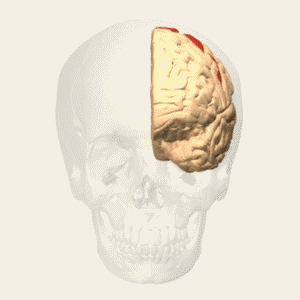Brodmann area 4
Brodmann area 4 (BA4) is a region of the cerebral cortex in the brain that is involved in motor function. It is located in the precentral gyrus and is also known as the primary motor cortex. This area is responsible for the execution of voluntary movements.
Anatomy and Location[edit | edit source]
Brodmann area 4 is situated in the frontal lobe of the brain, specifically in the precentral gyrus. It is bordered by Brodmann area 6 anteriorly and Brodmann area 3 posteriorly. The primary motor cortex is characterized by a thick layer of large pyramidal cells known as Betz cells, which are crucial for motor control.
Function[edit | edit source]
The primary function of Brodmann area 4 is to generate neural impulses that control the execution of movement. These impulses are sent to the spinal cord and then to the muscles, resulting in voluntary movement. The area is somatotopically organized, meaning different parts of the area correspond to different parts of the body, a concept known as the motor homunculus.
Clinical Significance[edit | edit source]
Damage to Brodmann area 4 can result in motor deficits such as paralysis or paresis of the muscles controlled by the affected area. This can occur due to stroke, traumatic brain injury, or other neurological conditions. Understanding the function and location of BA4 is crucial for neurosurgery and neurology.
Related Areas[edit | edit source]
- Brodmann area 6: Involved in the planning of movements.
- Brodmann area 3: Part of the primary somatosensory cortex.
- Motor cortex: Includes BA4 and other areas involved in motor control.
- Precentral gyrus: The gyrus where BA4 is located.
See Also[edit | edit source]
References[edit | edit source]
External Links[edit | edit source]
This article is a neuroanatomy stub. You can help WikiMD by expanding it!
Search WikiMD
Ad.Tired of being Overweight? Try W8MD's physician weight loss program.
Semaglutide (Ozempic / Wegovy and Tirzepatide (Mounjaro / Zepbound) available.
Advertise on WikiMD
|
WikiMD's Wellness Encyclopedia |
| Let Food Be Thy Medicine Medicine Thy Food - Hippocrates |
Translate this page: - East Asian
中文,
日本,
한국어,
South Asian
हिन्दी,
தமிழ்,
తెలుగు,
Urdu,
ಕನ್ನಡ,
Southeast Asian
Indonesian,
Vietnamese,
Thai,
မြန်မာဘာသာ,
বাংলা
European
español,
Deutsch,
français,
Greek,
português do Brasil,
polski,
română,
русский,
Nederlands,
norsk,
svenska,
suomi,
Italian
Middle Eastern & African
عربى,
Turkish,
Persian,
Hebrew,
Afrikaans,
isiZulu,
Kiswahili,
Other
Bulgarian,
Hungarian,
Czech,
Swedish,
മലയാളം,
मराठी,
ਪੰਜਾਬੀ,
ગુજરાતી,
Portuguese,
Ukrainian
Medical Disclaimer: WikiMD is not a substitute for professional medical advice. The information on WikiMD is provided as an information resource only, may be incorrect, outdated or misleading, and is not to be used or relied on for any diagnostic or treatment purposes. Please consult your health care provider before making any healthcare decisions or for guidance about a specific medical condition. WikiMD expressly disclaims responsibility, and shall have no liability, for any damages, loss, injury, or liability whatsoever suffered as a result of your reliance on the information contained in this site. By visiting this site you agree to the foregoing terms and conditions, which may from time to time be changed or supplemented by WikiMD. If you do not agree to the foregoing terms and conditions, you should not enter or use this site. See full disclaimer.
Credits:Most images are courtesy of Wikimedia commons, and templates, categories Wikipedia, licensed under CC BY SA or similar.
Contributors: Prab R. Tumpati, MD





